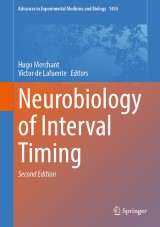Details
Neurobiology of Interval Timing
Advances in Experimental Medicine and Biology, Band 1455 Second Edition 2024
|
235,39 € |
|
| Verlag: | Springer |
| Format: | |
| Veröffentl.: | 25.06.2024 |
| ISBN/EAN: | 9783031601835 |
| Sprache: | englisch |
| Anzahl Seiten: | 500 |
Dieses eBook enthält ein Wasserzeichen.
Beschreibungen
<p>The study of how the brain processes time is becoming one of the most important topics in systems, cellular, computational, and cognitive neuroscience, as well as in the physiologic bases of music and language. During the last and current decade, interval timing has been intensively studied in humans and animals using increasingly sophisticated approaches. This new edition of the <em>Neurobiology of Interval Timing </em>integrates the current knowledge of animal behavior and human cognition of the passage of time in different behavioral contexts, including the perception and production of time intervals, as well as rhythmic activities. The chapters are written by the leading experts in the fields of psychophysics, functional imaging, systems neurophysiology, and musicology. The new edition features a complete updating of the content with many new chapters. The main updates are the remarkable advances in our understanding of the neural basis of temporal processing in monkeys, rodents, and humans. The notion is that the neural clock depends on the dynamics of neural populations in the motor system, and that this general internal time representation interacts with the sensory and cognitive systems depending on the timing requirements and the behavioral contingencies of a specific task. Also, this edition delineates a clearer distinction between interval-based and beat-based timing in humans. </p>
<p>Part I: Neurobiology of interval timing.- A second introduction to the Neurobiology of Interval Timing.- Creating a home for timing researchers: Then, now, and the future.- The processing of short time intervals: Some critical issues.- Models of Interval Timing: Seeing the forest for the trees.- Part II: Neurophysiology of timing.- Neural sequences and the encoding of time.- Temporal information processing in the cerebellum and basal ganglia.- Diverse time encoding strategies within the medial premotor areas of the primate.- Interactions of temporal and sensory representations in the basal ganglia.- Estimating time and rhythm by predicting external stimuli.- Cognition of time and thinkings beyond.- Part III: Timing in humans.- The motor of time: Coupling action to temporally predictable events heightens perception.- Coordinate-Based Meta-Analyses of the Time Perception Network.- Probing beat perception with event-related potentials (ERPs) in human adults, newborns, and non-human primates.- Rhythms in speech.- Timing patterns in the extended basal ganglia system.</p>
<p><strong>Hugo Merchant, PhD,</strong> is Professor of Neurobiology and Systems Neuroscience, Institute of Neurobiology, Universidad Nacional Autonoma de Mexico, Juriquilla, Mexico. His research focuses on the neural basis of time. He has served as Associate Editor of the Journal of Neuroscience of and the Journal of Neurophysiology, and on the Editorial Boards of eLife, Frontiers in System Neuroscience, and Frontiers in Integrative Neuroscience. </p>
<p> </p>
<p><strong>Victor de Lafuente, PhD,</strong> is Professor of Neurobiology, Institute of Neurobiology, Universidad Nacional Autonoma de Mexico, Queretaro, Mexico. His research interests are centered around the neuronal correlates of sensory perception, motor planning, and decision making. He is on the Board of Senior Editors for Neuroscience and is on the Editorial Boards of Frontiers In Molecular Neurobiology and Frontiers in Systems Neuroscience</p>
<p> </p>
<p> </p>
<p> </p>
<p><strong>Victor de Lafuente, PhD,</strong> is Professor of Neurobiology, Institute of Neurobiology, Universidad Nacional Autonoma de Mexico, Queretaro, Mexico. His research interests are centered around the neuronal correlates of sensory perception, motor planning, and decision making. He is on the Board of Senior Editors for Neuroscience and is on the Editorial Boards of Frontiers In Molecular Neurobiology and Frontiers in Systems Neuroscience</p>
<p> </p>
<p> </p>
<p>The study of how the brain processes time is becoming one of the most important topics in systems, cellular, computational, and cognitive neuroscience, as well as in the physiologic bases of music and language. During the last and current decade, interval timing has been intensively studied in humans and animals using increasingly sophisticated approaches. This new edition of the <em>Neurobiology of Interval Timing</em> integrates the current knowledge of animal behavior and human cognition of the passage of time in different behavioral contexts, including the perception and production of time intervals, as well as rhythmic activities. The chapters are written by the leading experts in the fields of psychophysics, functional imaging, systems neurophysiology, and musicology. The new edition features a complete updating of the content with many new chapters. The main updates are the remarkable advances in our understanding of the neural basis of temporal processing in monkeys, rodents, and humans. The notion is that the neural clock depends on the dynamics of neural populations in the motor system, and that this general internal time representation interacts with the sensory and cognitive systems depending on the timing requirements and the behavioral contingencies of a specific task. Also, this edition delineates a clearer distinction between interval-based and beat-based timing in humans. </p>
Presents the definitive reference in the field Provides an extensive update of the first edition with many completely new chapters on both interval-based and beat-based timing This provides the current knowledge of animal behavior and human cognition


















